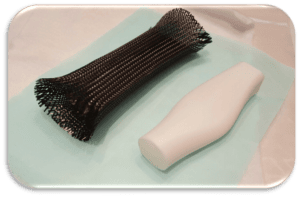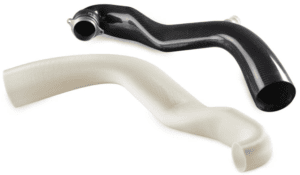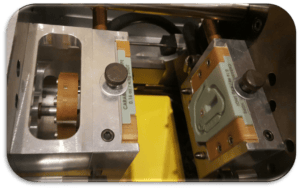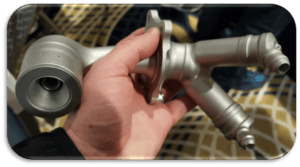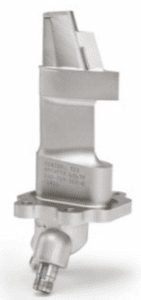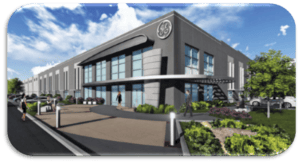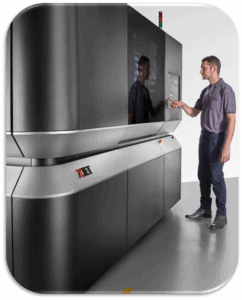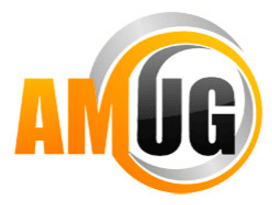
Stratasys unveiled a new 3D printer on the first day of AMUG and it is phenomenal! It is called the Stratasys J750. The user has the ability to print with 6 different materials at the same time choosing between 360,000 different colors! What other 3D printer is there that you can load Digital ABS, Tango (rubber), and different colors and build with them? NONE! Stratasys also revamped their print heads by doubling the amount of nozzles per material which results in better layer resolution! All print modes have finer layers resulting in better aesthetics than any other printer previous with High Quality layers at 14 microns! By teaming up with Adobe, the user can import a CAD file into Adobe Photoshop to assign a color pattern, picture, or even a texture to their CAD file. To say I am excited about this printer is an understatement! I need one now!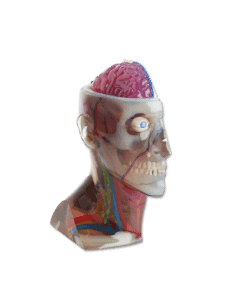

STRATASYS WORKSHOPS:
Carbon fiber soluble core workshop
In this workshop we learned how to setup a soluble core, that was printed on a Stratasys Fortus 450 MC using the SR-30 support, for a carbon fiber application. This is a great application for the soluble support material. Turns out there are many customers using this application so that they don’t have to inventory expensive tools and can print on demand cores for their customers.
During this presentation we learned that you will need to sand the part and then apply some sealing agent to the core/mandrel. As for what type of sealing agent works best? The answer is all. They haven’t had any issues with different sealing agents from different vendors. Several coats are needed. When the part is building, you have the ability to setup pauses in the build so that you can add inserts or bushings to the part. Because Aluminum dissolves in Sodium Hydroxide, you will want to use a different metal.
If this is a application that you are interested in, please email me at James.barker@padtinc.com and I will respond ASAP to you inquiries.
Injection Mold 3D Printed Inserts
This application is a huge money and time saver as well! In this picture the inserts were 3D printed using a Digital ABS-Like material from a Polyjet printer. The brackets and ejector plate were printed using the FDM technology and built out of Ultem 1010. These builds took under 3 hours to build and allow the customer to quickly inject material to prove the design using the actual material required! A few months ago we held a seminar in Utah at 2 different locations and taught this application with a Stratasys expert. Here is a neat video Professor Jonathan George did showing this application in use: YouTube.
Here is a video that Stratasys put out that shows their printers in use and the whole process as well. YouTube
ADDITIVE MANUFACTURING at GE AVIATION
LEAP Engine Fuel Nozzle
GE’s biggest success story is their LEAP Engine Fuel Nozzles. For each LEAP engine manufactured there are 19 fuel nozzles needed. Instead of assembling them by hand they are now all 3D printed. 10,000 engines have been sold to date since the engine was introduced in 2012. By 2018, GE needs to 3D print 35,000 fuel nozzles and by 2020, they have estimated that they will need a total of 100,000 nozzles. There is a 25% weight reduction and these parts are 5 times more durable than conventional manufacturing methods.
T25 Temperature Sensor
This housing is an inlet temperature sensor that was the 1st 3D printed part certified by the FAA to fly inside a GE commercial jet engine! GE Aviation is retrofitting 400 GE90-94B engines that power Boeing 777’s. These sensors are subjected to all elements so there was rigorous testing done to ensure safety.
The Center for Additive Technology Advancement CATA
This facility is already open and running. The goal is to advance Additive Manufacturing across all divisions of GE. More information can be found here.
XJET – NEW METAL TECHNOLOGY

AMUG was XJET’s unveiling of their new metal technology. XJET was formed in 2005 by the inventors of Objet/Polyjet technology. Since 2005 they have been able to raise $170 million to help spur their new idea. They call it Nano Particle Jetting™. The way it works is they take a nano particle of metal and suspend it in a liquid material that is then jetted from the print heads very similar to how Polyjet printers work. Since the metal is infused in a liquid material there isn’t any harm dealing with powdered metals which eliminates the fear of dealing with a combustible powder metal! The parts are built in a heated chamber which evaporates the liquid material that was holding the nano particle. Another key part to their technology is the support material which is NOT the same material as the metal! During the presentation, Dror Danai mentioned that there is no need to remove the support material with a mechanical process. The parts will need to be annealed to remove stresses that occur during the printing process. While the part is being annealed the support material will be removed. I am not sure how this is done, but it was hinted that the support dissolves or evaporates away.
The print heads have 512 nozzles on each of them that can jet 18,000 droplets per second which helps achieve a layer thickness as fine as 2 Microns!! Currently XJET has 7 machines that they are operating. 6 are in R&D and 1 is being used to print benchmarks for customers to help prove the technology. Here is a link to their website showing how their technology works: XJET
If you would like to see this printer in person you can at RAPID which is in Orlando, Florida from May 16-19. Here is a link to RAPID.
CONCLUSION
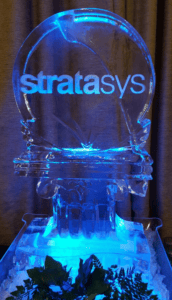
All in all I had a phenomenal time at AMUG and met some very interesting people that share my same passion for 3D printing. If you have the opportunity to go to RAPID this year in Florida, please let me know your thoughts of it. I have heard there are some new materials coming out from Stratasys along with new 3D printers that will be showcased. It is amazing where 3D printers have come from, and I am anxious to see where we are headed!
If you would like to contact me with any questions then please email me at this email address:
James Barker, Application Engineer
Phoenix Analysis & Design Technologies

